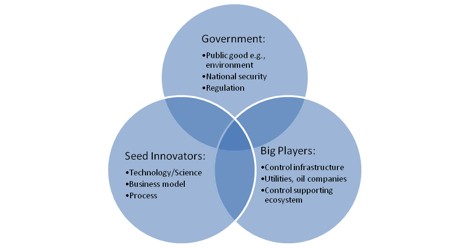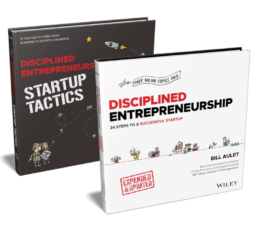Republished from Xconomy.
I had the good fortune to receive a substantial amount of feedback on my first post on this subject a few weeks ago. The feedback was productive and helped to clarify key points and in general reinforced my conviction laid out in the Part I entry. In that article, I advanced the idea that while “we should and must invest in renewables and alternative energy for the future,” to do so to the exclusion of hydrocarbons means “we are majoring in minors.”
My point was simply that a more balanced approach to our energy investments should be pursued that focuses as well on the hydrocarbon reality we face for the foreseeable future. While we develop alternatives for the longer term, I argued, we must simultaneously invest in making hydrocarbons a cleaner, more efficient form of energy—as well as energy efficiency initiatives. “Just to put this in perspective,” I wrote, “…If we could find a way to reduce CO2 emissions from automobiles by 1 percent it would be, from a quantitative and practical point of view, thousands of times more positively impactful than increasing solar energy production by a hundred times.”
The post generated a lot of comments, but the numbers behind my argument are quite compelling in the end, so I can’t say that my view has changed. My second installment on this subject will be regarding a topic that is much harder to qualify. But I believe it is another fundamental, yet often-overlooked factor that has to be dealt with more realistically if energy investing is to succeed: our critical shortage of energy entrepreneurs. Clearly, money for energy innovation is no longer an issue, but the entrepreneurs to effectively put that capital to work will prove to be a system constraint.
People in many industries will whine and complain about how their industry is so unique and more difficult than others, and so one has to sort through this groaning to find the truth. After some close analysis, though, I have concluded that for energy, unfortunately, it is definitely true. Energy entrepreneurship is much harder than entrepreneurship in other sectors, and I believe most investors have yet to come to grips with this fact.
To explain my case, I will break the discussion down into some key points (which follow below). These are general points about energy ventures and so may not apply specifically to individual cases—but in aggregate I believe them to be true. They present a real challenge for the energy sector today and into the near future.
All Entrepreneurs Are Not Alike, or Energy Entrepreneurs Are A Rare Breed Indeed
When new industries arise (e.g., computer hardware, software, telecom, internet, wireless, medical, biotech), they have their own unique characteristics. Obviously, the technical talent required differs greatly in these industries, but so do the entrepreneurial skills required. Entrepreneurs are the change agents who commercialize the disruptive invention, and the inventor (a technologist or some sort of visionary) needs them to create a meaningful new venture. The entrepreneur is the great integrator and the propeller of the new venture.
An entrepreneur who is successful in software usually is particularly skilled at identifying market opportunities and then executing a market-pull, customer-intimate, product strategy in a rapid fashion—getting innovations to market quickly and then iterating to improve the products. These skills are clearly transferable to Web 2.0 venture creation but are not as relevant, and, in fact, may be counterproductive, in a biotech entrepreneurial venture. Biotech entrepreneurs need to have a much more methodical approach over a longer period of time than Web entrepreneurs, and they must possess a distinct ability to manage a company and a project through significant regulatory obstacles. Similarly, as I will explain further, Energy Entrepreneurship is much different than any brand of entrepreneurship we have seen to date. In fact, I would argue that being an entrepreneur in the energy arena is unquestionably the hardest form of entrepreneurship by at least one order of magnitude.
While it’s easy for me to say that energy entrepreneurship is harder than entrepreneurship in other sectors, it’s a bit presumptuous of me to estimate how much tougher it is. I do so, however, to make the point that there is a big gap between it and other fields that people are underestimating right now. Let’s look at all the attributes or dimensions of expertise that an Energy Entrepreneur needs:
1. Multi-dimensional knowledge of science and engineering disciplines. While the entrepreneur is most often not the technologist or inventor, he (note: I use “he” and “his” in the gender neutral sense) does need to understand the core scientific drivers of the market as well as the technology or science drivers behind his various product offerings. For many new Energy Ventures that could well mean possessing an understanding of aspects of chemistry, biology, engineering, biotechnology, environmental science, computer science, and production systems, to name just a few. Does that make energy entrepreneurship unique amongst technology sectors? To the magnitude that such expertise is required, yes.
2. Longer time frame. While there are exciting exceptions like EnerNOC (NASDAQ: ENOC), the time frame required for an energy company to get traction is much longer than with companies in most other sectors. Ann Winblad, the software venture capitalist, said at the recent MIT Technology Review Emerging Technologies Conference that her companies took a long time to bear fruit—an average of 6.2 years. While for Ann that may seem long, most energy companies, even poster success stories like EverGreen Solar, can only dream of such short time horizons. While the current enthusiasm for energy companies is compressing the time before they bear fruit, the historical starting point (for good reasons) is significantly greater than 10 years. Indeed, if the time required for energy companies to bear fruit could be reduced to an average of 10 years, it would be a substantial improvement (Which raises a question as to how venture capitalists with 10-15-year funds can handle energy investing, but we must keep moving and stick to the main topic…). The persistence and patience that Ann said is so difficult to find for typical software startups is a fraction of what is required for energy companies. Biotech companies are similar in this regard, but in general, energy is far outside the bounds of other sectors.
3. Bigger scope and scale from a financial standpoint. Just from a financial standpoint, a typical energy new venture requires large amounts of capital. Investors have to make significant initial bets and then be ready to follow them up with even bigger bets. While energy is not unique (biotech, telecom, and now wireless—see Helio—come to mind as similar stories), it does add another dimension of required sophistication.
4. Ability to deal with public perception and often-intense emotion. Energy is inextricably tied to controversial natural resources, public safety, and environmental issues—not to mention questions about economic impact. Part and parcel with this come public politics and emotion. Some of it is clearly justified, and some of it is not. But, as ex-football coach Bill Parcells said, “it is what it is,” and the energy entrepreneur needs to be adept at dealing with it. (See the comments on my first post for evidence of this tendency.)
5. Adroitness in governmental affairs. Energy is not just emotional—it is politically charged with a significant policy dimension. If one chases down the full value chain of energy-related products, he or she will almost always find that they are directly affected by governmental actions. This action can be regulation (such as utility rate setting in the U.S.), subsidies (e.g, U.S. or Brazil ethanol production or Germany’s solar industry) or price setting (think OPEC). This is generally something entrepreneurs (and venture capitalists) hate. It’s not unique to the energy sector: the medical and biotech arenas have similar considerations. Strong capability and comfort in dealing with government affairs relating to policy and economic issues is absolutely critical to the successful energy entrepreneur.
Any one of these factors alone adds complexity to the already challenging task an entrepreneur faces, but the challenge becomes particularly daunting when the compounding effect is considered.
Numerous Routes for Attackers in Other Fields, Not in Energy
In addition to these traits, there is another important and challenging market condition that exists in energy that is fundamentally different from other high tech industries today. It is the imperative to effectively deal with (e.g., by partnering, collaborating, or at least neutralizing) the very people you are trying to disrupt. To a much greater degree than in other sectors the existing hierarchy in energy cannot be ignored.
Entrepreneurs thrive as “attackers” armed with disruptive technologies, business models, or other ideas that they bring to bear against the “defenders”—specifically the entrenched, resource-endowed hierarchy that is being threatened. Since the demise of IBM’s monopoly (Isn’t it hard to fathom that less than 25 years ago the biggest concern IBM had was anti-trust suits because it dominated the computer market so completely?), there have been multiple options for technology-based entrepreneur-attackers to create new products and to get to market. There has not been a dependence on a real or de facto monopoly on the defender side. It has been relatively easy to bypass the defender completely, or use defenders against each other to get the disruptive innovation to market.
For example, when Lotus came up with its breakthrough 1-2-3 spreadsheet, it did NOT have to work with IBM to have it fit into IBM’s closed mainframe architecture. It could operate on the open personal computer platform. Today, when Web 2.0 companies arise, there are no monopolies controlling the infrastructure that they need to deliver their offerings to customers.
Contrast this to the entrepreneur who wants to harness wind energy in the Dakotas and finds that there is no grid available to deliver the energy to the customer. To solve this problem would require dealing with numerous de facto monopolies (including utility companies but also state, local, and federal governments) that ultimately make the problem essentially intractable.
Energy entrepreneurs, especially those in energy production, don’t enjoy the luxury of having numerous possible routes to market—because it is almost always the case (even though they try to avoid it if they can and a few succeed) that they must deal with the existing hierarchy, which controls the infrastructure.
This is a difficult challenge in general because existing successful hierarchies are very content in homeostasis and resist significant changes (as Clayton Christensen details in The Innovator’s Dilemma). In energy, it is even significantly more challenging because those controlling the infrastructure are notoriously (and appropriately) conservative beyond what would be seen in other industries. While renewable and energy efficiency entrepreneurs might complain about utilities (sometimes with justification), they don’t have an option but to deal with them. Building a parallel grid is not a viable option. They must find extremely creative ways of working with the controllers of the infrastructure. Likewise, to be a player in the massive oil and gas industry, entrepreneurs usually need to find a way to work with those who control that infrastructure. The costs of the infrastructure are just so high in energy that having multiple options is much less likely than in other industries. It is not simply a barrier that was created because someone “built a brand”—there are huge costs required to build the infrastructure which cannot be overcome with a marketing program.
In Summary, Thoughts and Action on the Solution
As Albert Einstein said, “seek simplicity and distrust it.” The model I am proposing is not relevant for all energy startups, but it is for the majority of impactful new ventures that should and need to be created. The energy entrepreneur has to be able to manage significant technical resources to address the multidimensional science, engineering, and systems challenges which alone would exceed the entrepreneurial requirements for any other industry. If that were all, it would be enough—but it is not.
Like the most elite hi gh-tech entrepreneurs, the Renaissance Energy Entrepreneur must have these multi-disciplinary science and technology skills like an elite high-tech entrepreneur, represented in the “Seed Innovators” circle in the model to the right. These include understanding and building innovative business models to optimize monetization, as well as a keen awareness of the standard successful new venture creation process. This must be managed over a long period of time while simultaneously addressing the other two circles shown in the diagram—the “Government” (policy and public relations) circle and the “Big Players” circle (representing the need to diplomatically and effectively “massage the existing controllers of the infrastructure”). This combination is what makes this an exponentially more difficult task. The Energy Entrepreneur today who can do this is very rare indeed and in huge demand.
gh-tech entrepreneurs, the Renaissance Energy Entrepreneur must have these multi-disciplinary science and technology skills like an elite high-tech entrepreneur, represented in the “Seed Innovators” circle in the model to the right. These include understanding and building innovative business models to optimize monetization, as well as a keen awareness of the standard successful new venture creation process. This must be managed over a long period of time while simultaneously addressing the other two circles shown in the diagram—the “Government” (policy and public relations) circle and the “Big Players” circle (representing the need to diplomatically and effectively “massage the existing controllers of the infrastructure”). This combination is what makes this an exponentially more difficult task. The Energy Entrepreneur today who can do this is very rare indeed and in huge demand.
First, we need to openly recognize the challenge in front of us and not believe there are simple solutions. I recently heard a very smart venture capitalist say that he plans to “take successful entrepreneurs from other industries who want to give back now and put them in energy.” In general, I find this approach sorely lacking. For a sports analogy (which is a bit of a stretch I know, but it makes my point), transferring Michael Jordan’s extremely prodigious mental and physical athletic talents from basketball to baseball didn’t really work—nor will it generally work in energy entrepreneurship. The idea of transferring entrepreneurs from other industries and putting them in energy may be our only option in the short term, but they risk getting whiplash as they seek to master steep learning curves in multiple dimensions.
At MIT, starting in our “Energy Ventures” class, we seek to build this new renaissance energy entrepreneurship capability by having multi-disciplined teams working off the model above. We have selected a number of the most talented and passionate students at MIT from multiple science disciplines and coupled them with top policy graduate students and MBAs with significant energy background and put them into teams to work on building new energy companies. We are watching the experiment with great interest. The full results are not in, but we do know that it is much different and much harder than most people realize.
There are many other efforts to cultivate energy entrepreneurship in organizations such as the MIT Energy Club, MIT Enterprise Forum, TIE (The Indus Entrepreneurs), and the like. We plan to create a unified competition platform (the MIT Energy Prize) with significant support for prospective energy entrepreneurs inside and outside our community to help audition and improve their skills in a highly constructive, networking environment. It will be a learning process for everyone.
While there is still much to learn, we do know that in time, through these efforts (and many others), a new breed of entrepreneurs, the energy entrepreneurs, will arise to meet the challenges of the energy sector. When that day comes, another major bottleneck to resolving the energy challenge will be removed. But until then, we must recognize the limit in the system and act appropriately.
The author
Bill Aulet
A longtime successful entrepreneur, Bill is the Managing Director of the Martin Trust Center for MIT Entrepreneurship and Professor of the Practice at the MIT Sloan School of Management. He is changing the way entrepreneurship is understood, taught, and practiced around the world.

The Disciplined Entrepreneurship Toolbox
Stay ahead by using the 24 steps together with your team, mentors, and investors.
The books
This methodology with 24 steps and 15 tactics was created at MIT to help you translate your technology or idea into innovative new products. The books were designed for first-time and repeat entrepreneurs so that they can build great ventures.

How relevant was this article to you?
Click on a star to rate it!
Average rating 5 / 5. Vote count: 2
No votes so far! Be the first to rate this post.
We are sorry that this article was not useful for you!
Let us improve this post!
Tell us how we can improve this post?
